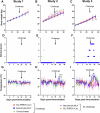A centralised immunogen approach to develop a more broadly protective modified live porcine reproductive and respiratory syndrome virus 1 vaccine candidate
- PMID: 40544181
- PMCID: PMC12182563
- DOI: 10.1038/s41541-025-01192-z
A centralised immunogen approach to develop a more broadly protective modified live porcine reproductive and respiratory syndrome virus 1 vaccine candidate
Abstract
More efficacious vaccines are required to improve control of porcine reproductive and respiratory syndrome viruses (PRRSV). One strategy that has shown promise is the use of centralized antigens, generated from consensus sequence data. Here, we evaluated the consensus sequence approach to develop a PRRSV-1 modified live virus (MLV) vaccine candidate, 'EU-PRRSV-Con'. EU-PRRSV-Con strain was engineered by inserting consensus sequence open-reading frames encoding envelope proteins of 67 PRRSV-1 strains into an attenuated PRRSV-1 strain backbone. EU-PRRSV-Con was evaluated in pigs and benchmarked against a licensed MLV vaccine. Efficacy was assessed against three different PRRSV-1 isolates. Neutralizing antibodies were elicited by EU-PRRSV-Con, which were more reactive than those induced by the licensed MLV. EU-PRRSV-Con provided better levels of protection (reduced viral loads and lung pathology) than the licensed MLV, although the efficacy against a divergent PRRSV-1 subtype 3 strain was more limited. These data support the development of EU-PRRSV-Con as a vaccine that may aid control of PRRSV-1.
© 2025. The Author(s).
Conflict of interest statement
Competing interests: The authors declare no competing interests.
Figures






References
-
- Lunney, J. K. et al. Porcine Reproductive and Respiratory Syndrome Virus (PRRSV): pathogenesis and interaction with the immune system. Annu. Rev. Anim. Biosci.4, 129–154 (2016). - PubMed
-
- Wensvoort, G. et al. Mystery swine disease in the Netherlands: the isolation of Lelystad virus. Vet. Q13, 121–130 (1991). - PubMed
-
- Vu, H. L. X., Pattnaik, A. K. & Osorio, F. A. Strategies to broaden the cross-protective efficacy of vaccines against porcine reproductive and respiratory syndrome virus. Vet. Microbiol.206, 29–34 (2017). - PubMed
Grants and funding
- BBS/E/I/00007031/BB_/Biotechnology and Biological Sciences Research Council/United Kingdom
- BBS/E/I/00007031/BB_/Biotechnology and Biological Sciences Research Council/United Kingdom
- BBS/E/I/00007031/BB_/Biotechnology and Biological Sciences Research Council/United Kingdom
- BBS/E/I/00007031/BB_/Biotechnology and Biological Sciences Research Council/United Kingdom
- BBS/E/I/00007031/BB_/Biotechnology and Biological Sciences Research Council/United Kingdom
LinkOut - more resources
Full Text Sources

